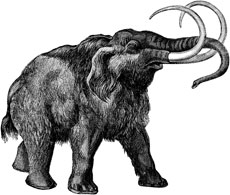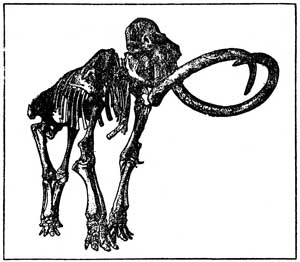|

Mini-mammoth: It is a common misconception that mammoths were much larger than modern elephants, an error that has led to "mammoth" being used as an adjective meaning "very big". Certainly, the largest known species, the Imperial Mammoth of California, reached heights of at least 4 meters (13 feet) at the shoulder. Mammoths would probably weigh in the region of 6-8 tons. However, most species of mammoth were only about as large as a modern Asian Elephant, and fossils of a species of dwarf mammoth have been found on Wrangel Island off the east coast of Siberia as well as the Californian channel islands (M. exilis) and some Mediterranean Islands.

 Not Your Average Elephant: Mammoths had a number of adaptations to the cold, most famously the thick layer of shaggy hair, up to 50 cm (20 in) long, for which the Woolly mammoth is named. Not Your Average Elephant: Mammoths had a number of adaptations to the cold, most famously the thick layer of shaggy hair, up to 50 cm (20 in) long, for which the Woolly mammoth is named.
They also had far smaller ears than modern elephants; the largest mammoth ear found so far was only a foot (30 cm) long, compared to six feet (1.8 m) for an African elephant. They had a flap of hairy skin which covered the anus, keeping out the cold.
Adaptations to Environment: Their teeth were also adapted to their diet of coarse tundra grasses, with more plates and a higher crown than their southern relatives. Their skin was no thicker than that of present-day elephants, but unlike elephants they had numerous sebaceous glands in their skin which secreted greasy fat into their hair, improving its insulating qualities. They had a layer of fat up to 8 cm (3 in) thick under the skin which, like the blubber of whales, helped to keep them warm.
Terrifying Tusks: Mammoths had extremely long tusks - up to 16 feet (5 m) long - which were markedly curved, to a much greater extent than those of elephants. It is not clear whether the tusks were a specific adaptation to their environment, but it has been suggested that mammoths may have used their tusks as shovels to clear snow from the ground and reach the vegetation buried below.
 Mammoth Evolution: Mammoth remains have been found in Europe, Africa, Asia, and North America. Mammoth Evolution: Mammoth remains have been found in Europe, Africa, Asia, and North America.
They are believed to have originally evolved in North Africa about 4.8 million years ago, where bones of Mammuthus africanavus have been found in Chad, Libya, Morocco
and Tunisia.
Asian or African? Despite their African ancestry, they are in fact more closely related to the modern Asian elephant than either of the
two African elephants. The common ancestor of both mammoths and Asian elephants split from the line of African elephants about 6 - 7.3 million years ago. The Asian elephants and mammoths diverged about half a million years later (5.5 - 6.3 million years ago).
In due course the African mammoth migrated north to Europe and gave rise to a new species, the southern mammoth (Mammuthus meridionalis). This eventually spread across Europe and Asia and crossed the now-submerged Bering Land Bridge into North America.
 The Beginning of the End: The Beginning of the End:
Around 700,000 years ago, the warm climate of the time deteriorated markedly and the savannah plains of Europe, Asia and North America gave way to colder and less fertile steppes.
The southern mammoth consequently declined, being replaced across most of its territory by the cold-adapted steppe mammoth (Mammuthus trogontherii). This in turn gave rise to the woolly mammoth, Mammuthus primigenius) around 300,000 years ago. Woolly mammoths were better able to cope with the extreme cold of the Ice Ages.
One Successful Species: The woollies were a spectacularly successful species; they ranged from Spain to North America and are thought to have existed in huge numbers. The Russian researcher Sergei Zimov estimates that during the last Ice Age, parts of Siberia may have had an average population density of sixty animals per hundred square kilometers --equivalent to African elephants today.

 Rumor Mill: There have been occasional claims that the mammoth is not actually extinct, and that small isolated herds might survive in the vast and sparsely inhabited tundra of the northern hemisphere. Rumor Mill: There have been occasional claims that the mammoth is not actually extinct, and that small isolated herds might survive in the vast and sparsely inhabited tundra of the northern hemisphere.
In the late nineteenth century, there were, according to Bengt Sjögren (1962), persistent rumors about surviving mammoths hiding in Alaska. In October 1899, a story about a man named Henry Tukeman detailed him having killed a mammoth in Alaska and that he subsequently donated the specimen to the Smithsonian Institution in Washington, D.C.. But the museum denied the existence of any mammoth corpse and the story turned out to be a hoax. Sjögren (1962) believes the myth got started when the American biologist C.H. Townsend traveled in Alaska, saw Eskimos trading mammoth tusks, asked if there still were living mammoths in Alaska and provided them with a drawing of the animal.
Sightings Galore: In the 19th century, several reports of "large shaggy beasts" were passed on to the Russian authorities by Siberian tribesman, but no scientific proof ever surfaced. A French charge d´affaires working in Vladivostok, M. Gallon, claimed in 1946 that in 1920 he met a Russian fur-trapper that claimed to have seen living giant, furry "elephants" deep into the taiga. Gallon added that the fur-trapper didn't even know about mammoths before, and that he talked about the mammoths as a forest-animal at a time when they were seen as living on the tundra and snow. There was an alleged Soviet Air Force sighting during World War II, but this was not verified by a second sighting.

All text is available under the terms
of the GNU Free Documentation License
|